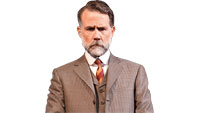

1. THEATRICAL EVENT OF THE YEAR
Black Watch
Hollywood filmmakers spent a lot of time and money this year trying to respond to the calamitous events of the world. Mainly they ended up with dry, earnest dramas: civics lessons on celluloid. A few Off Broadway plays got better results, from Ilan Hatsor’s Masked (about three brothers in Gaza) and J. T. Rogers’s The Overwhelming (about Americans fumbling through the Rwandan genocide) to Iphigenia 2.0, Charles Mee’s harrowing rewrite of the Greek tragedy adapted to the Bush years. But for unsettling power, political punch, and just plain fun, nothing matched watching ten actors from the National Theatre of Scotland at St. Ann’s Warehouse in Dumbo, where their performance of Gregory Burke’s Black Watch made for the all-around best theatergoing of the year. Their grunt’s-eye view of the war in Iraq combined interview transcripts with forays into the storied history of the Scots unit that gave the show its name. The result was an original and damning indictment of the American-led war. But unlike most of this year’s plays—even some very good ones—it wasn’t content merely to tell its story. Director John Tiffany unleashed the full arsenal of what a theater company can do: flaring video screens, choreographed sequences, songs, stuff blowing up, and a lot of heartfelt direct address to the audience, which drew us into the middle of the soldiers’ hellish lives. The show wasn’t just some gifted and thoughtful artists’ attempt to address the world, it was a pulse-pounding defense of the form itself.
2. BEST RETRO TREND
New Straight Plays Thrive on Broadway
The fall season has turned Broadway’s main drag into Serious Drama Alley, where four new plays are defying the gloomy drift toward revivals and tourist-happy musicals. Aaron Sorkin’s The Farnsworth Invention, Conor McPherson’s The Seafarer, Tom Stoppard’s Rock and Roll, and Tracy Letts’s August: Osage County all have their merits, but the latter two are flat-out triumphs. Stoppard has unfurled a multigenerational play about Czech politics and rock music; Letts has written a darkly funny and harrowing American family drama à la O’Neill (see review, page 64). Yet for all their differences, both are intensely personal creations, the playwrights’ attempts to use their own experiences to quicken our sense of the times in which we live. Together, Stoppard and Letts—authors of the best plays New York saw this year—have made their block the smartest spot in town.
3. BEST MUSICAL
In the Heights
In the world of old-fashioned Broadway tuners, Jonathan Tunick’s overture for LoveMusik, the show about the life and songs of Kurt Weill, offered five minutes of sublime beauty. Downtown, the Waterwell company achieved a messy kind of brilliance with The/King/Operetta, its show about the last year in the life of Martin Luther King Jr. The best musical of the year, however, did a remarkably persuasive job linking uptown and downtown—or, rather, uptown and way, way uptown. In the Heights uses salsa, hip-hop, and hints of Broadway balladry to capture a slice of Washington Heights onstage. Composer-narrator Lin-Manuel Miranda and librettist Quiara Alegria Hudes made this seem like the most natural fit in the world, even though nobody’s ever mixed these elements quite so well. Best of all, a tweaked version of the show will bring these long-overdue sounds to Broadway in early 2008.
4. MOST EXCITING PERFORMANCE
Liev Schreiber in Talk Radio
You could fill a wall in the Theater Hall of Fame with the actors who polished their claims to greatness on Broadway in 2007: Frank Langella as a charmingly reptilian Tricky Dick in Frost/Nixon, Christopher Plummer as the wily lawyer who knows every angle there is in Inherit the Wind, and Kevin Kline returning to form with his dashing, eloquent role in Cyrano de Bergerac (to say nothing of André De Shields, who is currently out-preaching the preacher and out–James Brown–ing James Brown in Langston Hughes’s Black Nativity Off Broadway). But the most exciting performance of the year came from Liev Schreiber, who took his biggest step yet toward joining their ranks. With a charismatic, sulfurous turn as a shock jock in Eric Bogosian’s Talk Radio, he showed that he can carry a show in a Broadway theater, not least by mesmerizing everybody in it. The force, the grace, and above all the voice: He’s got all the equipment he needs to rule Broadway one day.
5. MOST DURABLY CHARMING ANTI-ROMANCE
Henry Higgins and Eliza Doolittle (Whether They’re Singing or Not)
For sheer theatergoing delight, few evenings this year matched the Philharmonic’s staged concert version of My Fair Lady, starring Kelsey Grammer and the luminous Kelli O’Hara as Professor Higgins and Eliza Doolittle. But one show that came close was the Roundabout’s revival of George Bernard Shaw’s Pygmalion, the play that inspired the musical. The always-excellent Jefferson Mays and agreeably poised Claire Danes captured the charm and comedy of Higgins and Eliza’s not-quite-love affair. The story proves so timeless—and their performances so fine—that as wonderful as “I Could Have Danced All Night” sounded at the Philharmonic, you didn’t miss it at the Roundabout.
6. BEST RESURGENT JUGGERNAUT
Stephen Sondheim
Universally respected but intermittently loved composer of the most serious musicals in the Broadway canon, Sondheim had a very good year in 2007—as he did in 2006, 2005, and 2004. Follies, given a glittering revival by Encores! featuring Victoria Clark and Donna Murphy—two leading ladies at the top of their game—is the fourth Sondheim show in as many years to be not just admired but lavishly embraced by a New York audience, a hot streak that includes the shattering Assassins, the brilliantly bloody Sweeney Todd (onstage and now onscreen), and the coolly unsettling Company. Few sights in the city’s culture these days are more gratifying than watching the greatest living stage composer, now 77, have his work cherished anew while he’s here to enjoy it.
7. BEST FAIRY-TALE ENDING
Spring Awakening
When the year started, Spring Awakening was a critics’ darling facing long odds for survival. Did an audience exist for a pop-musical version of a 116-year-old German play about hormonal teens featuring onstage nudity, simulated masturbation, S&M, and the dirty words they don’t air on MTV? As the year ends, Duncan Sheik and Steven Sater’s show is a runaway hit: the winner of eight Tony awards, including Best Musical, a crossover phenomenon (compliments of a Gap ad featuring the eye-candy cast), with box-office momentum that Jonathan Franzen’s bitchy tirade against the adaptation couldn’t impede. The success of this gutsy indie-rock show proves that the 21st-century musical doesn’t just live: It kicks ass.
8. MOST GRATIFYING CANONIZATION
Thornton Wilder Joins the Library of America
Even though he won just about every honor an American writer can win (three Pulitzers, a National Book Award, the cover of Time), Thornton Wilder is the most neglected of this country’s great playwrights. The author of Our Town, The Skin of Our Teeth, and a handful of the best one-acts ever written got a much-deserved accolade this year from the Library of America, which added a volume of his plays and theatrical essays to the all but official canon of American letters. (With luck he’ll one day be joined by August Wilson, who also got a handsome literary tribute this year in Theater Communications Group’s boxed set of his ten-play cycle about the African-American experience.)

9. BEST SCENIC EFFECT
Passing Strange
Except for the occasional extravaganza like Charles Mee’s Queens Boulevard, which captures the raucous multicultural life of Astoria on Mimi Lien’s wonderfully busy set, new musicals lately run toward small casts on spare stages. Passing Strange, Stew’s coming-of-age musical at the Public, had a small cast, but there was nothing spare about the dazzling back wall. Scenic designer David Korins and lighting designer Kevin Adams collaborated on what looked like a giant circuit board or video-game console. It loomed even more impressively than the colossal lab in Young Frankenstein—its closest rival in terms of onstage coolness—at a fraction of the cost.

10. BEST SHAPE- SHIFTER
Boyd Gaines
A few of New York’s best and busiest actors flashed considerable range this year: Martha Plimpton (A Midsummer Night’s Dream and Cymbeline), Donna Murphy (Follies and LoveMusik), and Michael Cerveris (King Lear, LoveMusik, and Cymbeline). But nobody can touch the far-flung trio of outstanding performances given by Boyd Gaines: the lieutenant with the stiff upper lip in Journey’s End; Herbie, the agent with the heart of gold in Gypsy, and Colonel Pickering, the courtly, daffy phonetics researcher in Pygmalion. A war drama, a classic musical, and a Shavian comedy: It’s an awe-inspiring trifecta, all the more so because he made it look easy.

Debut
Zoe Kazan
After a brief appearance in The Prime of Miss Jean Brodie a year ago, young Zoe Kazan dazzled in a pair of performances this fall: an obnoxious kid falling to pieces in 100 Saints You Should Know and a wary recovering alcoholic in Things We Want. She makes lightning changes of mood and seems to be allergic to easy choices, and if she feels any fear, she’s hiding it extremely well.
Stinker
Local Revivals of the Classics
During another year in which major productions of classic plays were neither common nor impressive, it fell to the British director Edward Hall to remind New Yorkers what the great plays can do, dazzling a BAM crowd with his fierce and hilarious all-male Taming of the Shrew. By and large, topflight classical theater remains a horrible inversion of Broadway, in which the out-of-towners wow the locals.